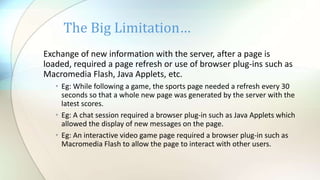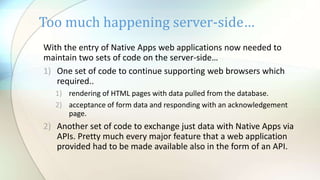SinglePageApplications
- 1. The What? Why? And How? Single Page Applications
- 2. The beginning of the beginningĄ (early 1990s) Request (GET) for a Static HTML Page Respond with requested Static HTML Page STATIC HTML PAGE
- 3. The beginning of the beginningĄ (early 1990s) Request (GET) for another Static HTML Page by clicking on a Hyperlink Respond with requested Static HTML Page FROM ONE PAGE TO ANOTHER
- 4. A little after the beginning of the beginningĄ. (mid 1990s) Submit new order to the server using an HTML form Store the order and respond with a confirmation HTML page. FORM SUBMISSION (POST)
- 5. A little after the beginning of the beginningĄ. (mid 1990s) Request for a Dynamic Page showing all orders so farĄ Generate a dynamic html page based on current data and respond with that page. DYNAMIC PAGES (GET)
- 6. Birth of a starĄ (1995) Request for a Page Respond with the page along with its corresponding JavaScript which adds behavior to the otherwise extremely boring and inactive page. JavaScript
- 7. Birth of another starĄ (1996) Request for a Page Respond with the page along with its corresponding CSS which gives a way to separate structure from presentation. CSS
- 8. The 3 stars that became super starsĄ Structure Presentation Behavior
- 9. Exchange of new information with the server, after a page is loaded, required a page refresh or use of browser plug-ins such as Macromedia Flash, Java Applets, etc. ? Eg: While following a game, the sports page needed a refresh every 30 seconds so that a whole new page was generated by the server with the latest scores. ? Eg: A chat session required a browser plug-in such as Java Applets which allowed the display of new messages on the page. ? Eg: An interactive video game page required a browser plug-in such as Macromedia Flash to allow the page to interact with other users. The Big LimitationĄ
- 10. Enter the game changer (2005)Ą Request for latest information behind the scenes without reloading the parent page using just plain JavaScript and no plug-ins. Respond with information requested that can be quickly integrated into the parent page by the browser without reloading.
- 11. Enter the devilryĄ Native Apps (2007) Request or send data in the form of XML or JSON while all the screens and their rendering is handled client-side. Respond with the requested data or acknowledge receipt of new data from the client.
- 12. Too much happening server-sideĄ With the entry of Native Apps web applications now needed to maintain two sets of code on the server-sideĄ 1) One set of code to continue supporting web browsers which required.. 1) rendering of HTML pages with data pulled from the database. 2) acceptance of form data and responding with an acknowledgement page. 2) Another set of code to exchange just data with Native Apps via APIs. Pretty much every major feature that a web application provided had to be made available also in the form of an API.
- 13. Need for better lifeĄ Maintaining two sets of code doing more or less the same thing is always a pain. How can we avoid it? Is it possible to come up with a way where we only need to maintain one or the other? WellĄ letĄŊs think about itĄ all we have to do is make the web browser behave like a Native App. How can we do that? WellĄ we have JavaScript which can render new elements based on data. It can also allow content to be changed within an element in the DOM. And we have AJAX which allows new content to be brought in without reloading the pageĄ So, all we need to do is to combine all these features!
- 15. A much better lifeĄ Request or send data in the form of XML or JSON while all the screens and their rendering is handled client-side. Respond with the requested data or acknowledge receipt of new data from the client.















